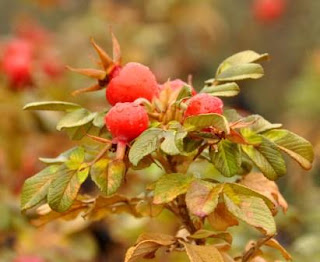The Rosa rugosa, which comes from Asia, is one tough personality in the garden. The variety Sandy was planted on the steep side of the ravine, just beyond the juniper hedge beside the labyrinth. Twenty or so were purchased from Musser Forests in spring 2003 to stabilize the soil after a landslide.
As the photo shows, the large hips provide spectacular color, even more than the slightly larger pink blossoms. The hips also last much longer than petals, though sadly do not have an interesting flavor, which some varieties provide.
If only they would stay in that difficult-to-grow-in area. Over the years, the plants have suckered their way up to the top of the ravine, where there is plenty of water available, and even occasional fertilizer. They have sent roots through the juniper, growing up and above the hedge. While it is a very pretty contrast of foliage and puts some dramatic color near eye level, the rose also creates enough shade to start killing off the juniper. Since the juniper is the only thing holding the soil in that particular place, and the rose will not do nearly as good of a job, the rose must be give away. Or, more accurately, the gardener must force it to behave!
While the bushes produce hips throughout the year, they reach their peak in the middle of the fall season, when the cool weather slows down their eventual decay to black. The first picture was taken in late November. It continued blooming and fruiting through light frosts.
But that all comes to an end when the weather turns seriously cold. Like this year.
Here is the current condition of that same cluster of hips. The deep red color is holding its own for now, but the leaves are rapidly declining. The leaves hang on for several weeks, adding to the decaying effect, and eventually the hips will turn brown then black. For a few more weeks, it offers some color in what is rapidly becoming a blend of muted browns and dark greens.
In February, when it is much easier to climb around the ravine, the stand of Rosa rugosa will be scanned for poorly placed shoots that need to be removed including as much root as possible. Older, thick stalks will be cut to the ground, encouraging new, strong growth from the root. It is a slow, prickly process, but the results are worth it.


No comments:
Post a Comment